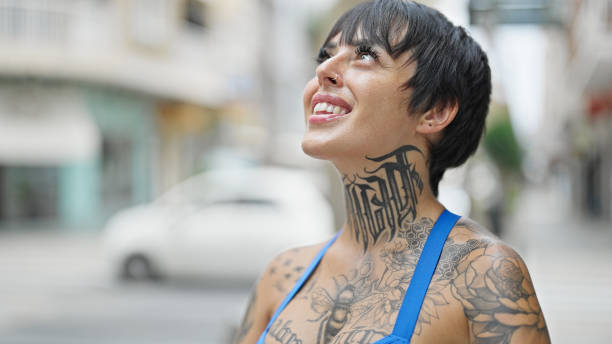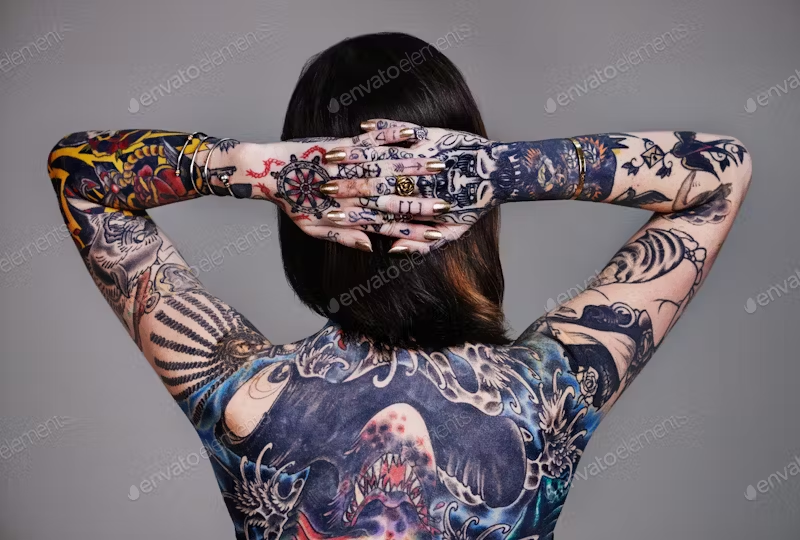Contents
Cultural Shifts and Acceptance of Tattoos

How Has Society’s Perception of Tattoos Changed Over the Years?
Tattoos have come a long way. Not too long ago, tattoos were often seen as a sign of rebellion. People with tattoos were sometimes judged harshly, and tattoos were associated with bikers, sailors, and those living on the fringes of society. However, things have changed dramatically in recent years.
Today, tattoos are more popular and widely accepted than ever. They are seen as a form of personal expression, a way for people to tell their stories, showcase their beliefs, or simply display beautiful art on their bodies. This shift in perception has made tattoos a common sight in all walks of life, from boardrooms to classrooms.
The Role of Celebrities and Influencers in Normalizing Tattoos
One of the biggest reasons for this change is the influence of celebrities and social media stars. Many famous people, like musicians, actors, and athletes, proudly display their tattoos. When fans see their favorite celebrities sporting tattoos, it can make getting inked seem cool and acceptable.
For example, celebrities like David Beckham, Rihanna, and Angelina Jolie have numerous tattoos and often talk about them publicly. Social media influencers also play a huge role. Platforms like Instagram and YouTube allow influencers to share their tattoo journeys with millions of followers, making tattoos seem more accessible and less taboo.
Generational Differences in Attitudes Towards Tattoos
Generational attitudes towards tattoos vary significantly. Older generations often view tattoos with skepticism. They grew up in a time when tattoos were less common and often associated with negative stereotypes. For them, tattoos might still carry a stigma.
In contrast, younger generations, like Millennials and Gen Z, generally have a much more positive view of tattoos. For many young people, tattoos are a normal part of life. They see them as a way to express individuality and creativity. It’s not uncommon for young adults to get their first tattoo as soon as they turn 18, often seeing it as a rite of passage.
As more young people get tattoos and older generations become more accustomed to seeing them, the overall acceptance of tattoos continues to grow. This cultural shift is evident in the increasing number of people getting tattoos, the variety of tattoo styles available, and the presence of tattoo parlors in mainstream locations.
Society’s perception of tattoos has evolved significantly, thanks in large part to the influence of celebrities and social media, as well as changing attitudes across generations. Tattoos are now widely seen as a legitimate form of self-expression, embraced by people from all walks of life.
The Psychology Behind Getting Tattoos

Exploring the Reasons Why People Choose to Get Tattoos
People get tattoos for many reasons, and each tattoo often has a personal story behind it. Here are some of the most common motivations:
1. Self-Expression: Many individuals use tattoos to express their personality, beliefs, or interests. A tattoo can be a powerful way to show what matters most to someone, whether it’s a favorite quote, an important symbol, or a meaningful image.
2. Memorializing: Tattoos are often used to honor loved ones who have passed away. These memorial tattoos can provide a sense of closeness and a way to keep the memory of a loved one alive.
3. Celebration: Significant life events, like the birth of a child, overcoming an illness, or reaching a personal milestone, are often commemorated with a tattoo.
4.Aesthetics: Some people simply appreciate the beauty of tattoo art. They enjoy the idea of carrying a piece of art on their skin and see their body as a canvas.
5. Cultural or Spiritual Reasons: In some cultures, tattoos have deep spiritual or cultural significance. They can symbolize rites of passage, religious beliefs, or cultural heritage.
The Emotional and Psychological Impact of Tattoos on Individuals
Getting a tattoo can have a profound emotional and psychological impact. Here’s how:
1. Empowerment: For many, getting a tattoo can be an empowering experience. It allows individuals to take control of their bodies and make a permanent statement about who they are.
2. Healing: Tattoos can play a role in the healing process. For some, they serve as a way to cope with trauma or significant life changes. The act of getting a tattoo can be a therapeutic experience, helping people process emotions and experiences.
3. Boosting Confidence: A well-chosen tattoo can boost a person’s confidence. It can make them feel unique, attractive, and more comfortable in their own skin.
4. Identity and Belonging: Tattoos can help individuals feel more connected to certain groups or communities. For example, matching tattoos with friends or family members can strengthen bonds and create a sense of belonging.
Tattoos as a Form of Self-Expression and Identity
Tattoos are a unique form of self-expression. They allow people to showcase their identity in a way that’s visible to the world. Unlike other forms of self-expression, like clothing or hairstyle, tattoos are permanent, making them a powerful statement about one’s identity.
1. Personal Stories: Every tattoo tells a story. Whether it’s a small, simple design or a large, intricate piece, each tattoo is a reflection of the individual’s journey, experiences, and values.
2. Individuality: Tattoos celebrate individuality. They allow people to stand out and differentiate themselves from others. In a world where many aspects of life are increasingly homogenized, tattoos offer a way to assert one’s uniqueness.
3. Artistic Expression: For some, tattoos are a form of art. They collaborate with tattoo artists to create custom designs that reflect their personal tastes and creativity.
4. Permanent Reminder: Tattoos can serve as permanent reminders of personal mottos, aspirations, or life lessons. They can act as daily affirmations or motivational symbols that help guide individuals through their lives.
In summary, tattoos are much more than just ink on skin. They are deeply personal and meaningful, offering a powerful way for people to express themselves, tell their stories, and navigate their emotional and psychological landscapes. Whether for self-expression, memorializing loved ones, or celebrating milestones, tattoos hold a significant place in the lives of many individuals.
Artistry and Innovation in Tattooing
The Evolution of Tattoo Artistry and Techniques
Tattoo artistry has undergone a remarkable transformation over the years. Here’s a look at how it has evolved:
1. Traditional Techniques: Early tattooing methods were often rudimentary, using sharpened bones or sticks to puncture the skin and insert pigments. These traditional techniques are still practiced in some cultures today, such as the hand-tapping method used by Polynesian tattoo artists.
2. Modern Technology: The invention of the electric tattoo machine in the late 19th century revolutionized tattooing. This machine, based on Thomas Edison’s electric pen, allowed for more precise and consistent tattooing. Today, advanced tattoo machines, equipped with multiple needles and capable of creating intricate designs, are standard.
3. Artistic Styles: Tattoo artistry has diversified into numerous styles, each with its own techniques and aesthetics. These include traditional American, Japanese, realism, watercolor, geometric, and neo-traditional styles. Each style has pushed the boundaries of what can be achieved with ink and skin.
4. Ink and Equipment Advances: Modern tattoo inks are more vibrant and safer than ever before. There has also been a rise in vegan inks and hypoallergenic options. Equipment advancements, like ergonomic tattoo machines and improved sterilization techniques, have made the process safer and more comfortable.
Prominent Tattoo Artists and Their Influence on the Industry
The world of tattooing is filled with talented artists who have left a significant mark on the industry. Here are a few prominent figures:
1. Sailor Jerry (Norman Collins): Known as the father of old-school tattooing, Sailor Jerry developed iconic American traditional designs that are still popular today. His bold lines and vibrant colors set a standard for tattoo quality.
2. Kat Von D: A celebrity tattoo artist and former star of the TV show “LA Ink,” Kat Von D is known for her detailed black-and-gray portraits. Her visibility has helped bring tattoo artistry into the mainstream.
3. Horisumi (Kian Forreal): An Australian artist trained in traditional Japanese tattooing, Horisumi’s work is highly respected for its adherence to the intricate and symbolic nature of Japanese art.
4. Paul Booth: Known for his dark, surrealist style, Paul Booth’s work is influential in the world of horror and fantasy tattoos. His intricate designs have earned him a dedicated following.
5. Dr. Woo: A celebrity favorite, Dr. Woo is known for his fine line and minimalist designs. His unique style has influenced a new generation of tattoo artists and enthusiasts.
The Rise of Tattoo Conventions and Their Significance
Tattoo conventions have become a cornerstone of the tattoo community, offering a space for artists, enthusiasts, and newcomers to celebrate the art form. Here’s why they are significant:
1. Showcasing Talent: Conventions provide a platform for tattoo artists from around the world to showcase their skills. Attendees can watch live tattooing, see a wide range of styles, and even get tattooed by renowned artists.
2. Learning and Inspiration: For aspiring tattoo artists, conventions are an invaluable resource. Workshops, seminars, and demonstrations offer learning opportunities from industry leaders. It’s a chance to stay updated on the latest techniques and trends.
3. Community Building: Conventions bring together people who share a passion for tattoos. They foster a sense of community and allow for networking among artists, suppliers, and enthusiasts. This helps strengthen the tattoo culture and supports the industry’s growth.
4. Innovation and Trends: New products, tools, and techniques are often introduced at conventions. This keeps the industry dynamic and constantly evolving. Attendees get to experience the latest innovations firsthand.
5. Cultural Exchange: With artists from diverse backgrounds, conventions facilitate a rich cultural exchange. Traditional and modern tattooing practices from different cultures are celebrated, preserving and honoring tattoo heritage.
The world of tattooing has seen significant evolution in artistry and techniques, influenced by pioneering artists and celebrated through vibrant conventions. This ongoing innovation ensures that tattooing remains a dynamic and respected art form.
Health and Safety in the Tattoo Industry

Advances in Tattoo Ink and Equipment for Safer Practices
The tattoo industry has made significant strides in improving health and safety through advancements in ink and equipment:
1. Tattoo Ink Improvements: Modern tattoo inks are developed to be safer and more durable. Many manufacturers now offer inks that are vegan, free from harmful chemicals, and less likely to cause allergic reactions. Advances in ink composition have also led to more vibrant and longer-lasting colors.
2. Sterile Equipment: Disposable needles and single-use ink caps are now standard in reputable tattoo studios, significantly reducing the risk of cross-contamination. Tattoo machines have also become more sophisticated, with features designed to ensure precise and hygienic application.
3. Autoclaves and Sterilization: High-quality tattoo parlors use autoclaves to sterilize reusable equipment. An autoclave uses high-pressure steam to eliminate all forms of bacteria and viruses, ensuring that any reusable items are completely sterile before they touch the skin.
The Importance of Hygiene and Regulations in Tattoo Parlors
Hygiene and strict adherence to regulations are critical in the tattoo industry to ensure client safety:
1. Licensing and Certification: Many regions require tattoo artists and studios to be licensed and certified. This typically involves passing health and safety inspections and demonstrating knowledge of best practices in sanitation.
2. Clean Work Environment: A reputable tattoo studio will maintain a clean and organized workspace. Surfaces should be disinfected regularly, and all tools should be sterilized. Artists should wear gloves and use new, sterile needles and ink for each client.
3. Client Education: Tattoo artists should provide clients with clear aftercare instructions to prevent infections and ensure proper healing. This includes advice on cleaning the tattoo, avoiding certain activities, and recognizing signs of infection.
Common Health Concerns and Aftercare Tips for Tattoos
While tattoos are generally safe when done by a professional, there are still health concerns to be aware of:
1. Infections: Infections can occur if the tattooing process or aftercare is not properly managed. Signs of infection include redness, swelling, pain, and pus. It’s important to follow aftercare instructions closely and seek medical attention if an infection is suspected.
2. Allergic Reactions: Some people may have allergic reactions to tattoo ink, particularly to certain colors. Symptoms include itching, redness, and swelling. If you have sensitive skin or allergies, discuss this with your tattoo artist beforehand.
3. Aftercare Tips
Keep it Clean: Gently wash the tattoo with mild soap and water, then pat dry with a clean towel.
Moisturize: Apply a thin layer of a recommended ointment or tattoo aftercare lotion to keep the skin hydrated.
Avoid Sun Exposure: Protect the tattoo from direct sunlight, as UV rays can cause fading and irritation.
Do Not Scratch or Pick: Avoid scratching or picking at the tattoo, as this can cause scarring and ink loss.
Stay Away from Water: Avoid soaking the tattoo in water (such as pools, hot tubs, or baths) until it is fully healed.
Tattoos in the Workplace

The Impact of Tattoos on Professional Life and Employment Opportunities
Tattoos can influence professional life and employment opportunities, but attitudes are changing:
1. Traditional Workplaces: In conservative or formal work environments, visible tattoos might still be frowned upon. Certain industries, such as finance or law, may have stricter policies regarding visible tattoos.
2. Modern Workplaces: Many modern workplaces, especially in creative industries like tech, design, and media, are more accepting of tattoos. Visible tattoos are often seen as a form of self-expression rather than a professional hindrance.
Changing Policies and Attitudes Towards Visible Tattoos in Various Industries
1. Relaxed Dress Codes: As society becomes more accepting of tattoos, many companies are relaxing their dress codes to allow employees to display their tattoos. This shift reflects broader cultural changes and a recognition of individual expression.
2. Industry-Specific Trends: Some industries, such as the fashion and entertainment sectors, actively embrace tattoos. In these fields, tattoos can enhance personal branding and help individuals stand out.
3. Inclusivity Initiatives: Companies committed to diversity and inclusion are increasingly adopting policies that protect employees with tattoos from discrimination. These policies aim to create a more inclusive and accepting workplace culture.
Stories of Individuals Navigating Their Careers with Tattoos
1. Corporate Professionals: Some corporate professionals with tattoos have found ways to navigate their careers by strategically covering their ink during important meetings or interviews. As workplace cultures evolve, many find they can be more open about their tattoos without negative repercussions.
2. Tattoo Artists Turned Entrepreneurs: Many successful tattoo artists have built their own businesses, creating thriving studios and even expanding into tattoo-related merchandise and media. Their tattoos are integral to their personal brand and business success.
3. Healthcare Workers: Some healthcare workers with tattoos share stories of how their ink helps build rapport with patients, especially younger individuals or those with tattoos themselves. Visible tattoos in healthcare can humanize practitioners and make them more relatable.
The tattoo industry continues to advance in health and safety, while societal attitudes toward tattoos in the workplace are becoming more accepting. Whether navigating professional life or expressing personal identity, tattoos are increasingly recognized as a legitimate and meaningful form of self-expression.
Tattoos have experienced a significant cultural shift from symbols of rebellion to widely accepted forms of self-expression and artistry. Advances in health and safety practices have ensured safer tattooing experiences, while the influence of celebrities and changing generational attitudes have helped normalize tattoos across various sectors of society. As workplace policies continue to evolve, tattoos are increasingly seen as legitimate and meaningful expressions of personal identity, embraced by people from all walks of life.





